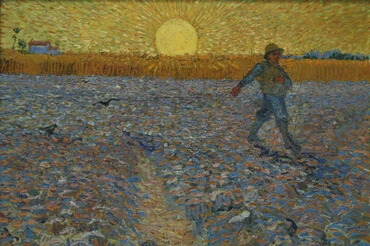A "field" in the Bible usually represents the Lord's church, and more specifically the desire for good within the church. It's where good things start, take root, and grow. When you have a desire to be a good person and to do good things, the natural first questions are "What does that mean?", "What should I do?", "What can I do?". You look for ideas, concepts, direction. Once you figure out something you want to do or a change you want to make in yourself, you seek specific knowledge. If you want to volunteer at a food pantry, say, you'd need to know whom to call, when they need help, where to go, what to bring. Armed with that knowhow, you're ready to get to work. That process could be compared to food production. You start with a field -- which is that desire to be good. Then you plant seeds -- those ideas and concepts. Those seeds sprout into plants -- the specific facts and knowledge needed for the task (easily seen in the food pantry example, but also true with deeper tasks like "being more tolerant of my co-workers" or "taking more time for prayer," or "consciously being a more loving spouse"). Finally, those plants produce food -- the actual good thing that you go and do. The Writings also say that in a number of cases a "field" represents the doctrine, or teachings, of the church. This sounds markedly different. The desire for good is emotional, a drive, a wanting; doctrine is a set of ideas. But for a church to be true, its doctrine must be centered on a desire for good, and must lead people toward doing what is good. So sound doctrine is actually closely bound up with the desire for good.
Arcana Coelestia #3365
3365. 'And Isaac went to Abimelech the king of the Philistines, to Gerar' means matters of doctrine concerning faith. This is clear from the representation of 'Isaac' as the Lord as regards the Divine Rational, dealt with in 1893, 2066, 2072, 2083, 2630 - 'Isaac' being the Lord's Divine Rational as regards Divine Good, 3012, 3194, 3210, and also as regards Divine Truth, which is represented by Isaac's marriage to Rebekah, 3012, 3013, 3077, so that 'Isaac' here represents the Lord as regards the Divine Truth joined to the Divine Good of the Rational, since Isaac was accompanied by Rebekah, and she was called his sister; from the representation of 'Abimelech' as the doctrine of faith which has regard to rational concepts, 2504, 2509, 2510, 2533; from the meaning of 'the king of the Philistines' as matters of doctrine - 'the king' in the internal sense being truth that is the truth of doctrine, see 1672, 2015, 2069, and 'the Philistines' the knowledge of cognitions, which are also matters of doctrine, 1197, 1198; and from the meaning of 'Gerar' as faith, 1209, 2504. From these meanings one may see what 'Isaac went to Abimelech the king of the Philistines, to Gerar' means, namely that the Lord is the source of the doctrine of faith which has regard to rational concepts, or what amounts to the same, to matters of doctrine concerning faith.
[2] The expression 'matters of doctrine' is used to describe all those things that constitute doctrine, and insofar as that doctrine is able to be received and to be acknowledged in heaven by angels and on earth by men it is said to have regard to rational concepts. Actually it is the rational that receives and acknowledges them; but the rational is such that it cannot possibly comprehend Divine things, for it is finite, and what is finite cannot comprehend anything of what is Infinite. For this reason Divine truths from the Lord present themselves before the rational by means of appearances. This is why matters of doctrine are no more than the appearances of Divine truth, that is, no more than celestial and spiritual vessels that hold what is Divine within them. And because they hold the Divine, that is, the Lord, within them, they therefore stir a person's affection, and thereby the Lord is joined to angels and to men.







